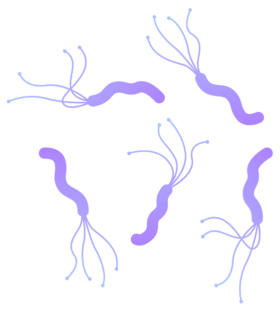New antibiotics needed: Helicobacter pylori
Posted on July 23, 2020 by Laura Cox
In 2017, the World Health Organization (WHO) published the ’12 Priority Pathogens’: a list of 12 microbes that are becoming increasingly resistant to current antimicrobials. These 12 pathogens are thought by WHO to pose the greatest threat to human health.
A prevalent pathogen
Helicobacter pylori is a bacterial pathogen that colonises the stomach of more than half of the world’s population. Years ago, almost everybody would have had these bacteria in their stomachs, but with more widespread use of antibiotics in young children, H. pylori is becoming less common. The bacterium is known as one of the main causes of stomach ulcers, but long-term infection with H. pylori has been formally designated a carcinogen and is a major cause of gastric cancer.
To survive in the harsh, acidic environment of the stomach, H. pylori is shaped like a corkscrew. Upon arrival, it releases large amounts of ammonia to overcome the highly acidic conditions. As quickly as possible, the bacterium drills down into the mucous lining of the stomach, where it then sits and causes infection.

A Nobel discovery
Despite its prevalence, we've only known about this organism for a relatively short period of time. In the 1980s, Robin Warren, a pathologist working in Perth, Australia, identified bacteria-like shapes on tissue samples taken from people with stomach ulcers. Warren teamed up with a gastroenterologist called Barry Marshall, to determine whether these new bacteria were the cause of stomach ulcers. At this time, the consensus in the scientific community was that stomach ulcers were caused by lifestyle factors such as diet or stress. Warren and Marshall’s theory was shot down again and again, was denied research grants and rejected from publication in scientific journals.
For their hypothesis to be considered by the scientific community, Warren and Marshall had to demonstrate cause and effect. To do this, they took a very high-risk strategy: they drank live culture of H. pylori. After a few days, Barry Marshall started to show symptoms including a stomach ache, bad breath and widespread inflammation of his stomach lining. They continued this experiment for a number of weeks, until Marshall took antibiotics to clear this self-inflicted infection. Although they didn’t prove that H. pylori was the cause of stomach ulcers, Warren and Marshall were able to show that the bacterium causes severe inflammation of the stomach lining. In 2005 they were awarded the Nobel Prize in Physiology and Medicine for their discovery of the bacterium and its effects.

A growing threat
The standard treatment for H. pylori infection is a triple therapy. consisting of a low dose of clarithromycin (CLA), a proton pump inhibitor – which prevents the bacterium from actively removing the antibiotic from within the cell – and either amoxicillin or metronidazole. In 2017, just 35 years after its discovery, WHO identified H. pylori as one of the 12 bacterial pathogens that pose the greatest threat to human health. This was due to the microbe developing resistance to the antibiotic CLA. As resistance to CLA continues to rise in H. pylori populations, treatment failure is becoming more frequent, meaning that alternative treatments are vitally needed.
In their review Trends in Helicobacter pylori resistance to clarithromycin: from phenotypic to genomic approaches, Andreia Marques, Jorge Vítor and colleagues discuss the mechanisms of resistance to CLA, including the mutations which contribute. They also discuss the methods used to detect CLA resistance in H. pylori and implications of the increasing resistance rate. The open-access review, published in the journal Microbial Genomics is the eleventh in the New Antibiotics Needed collection.

